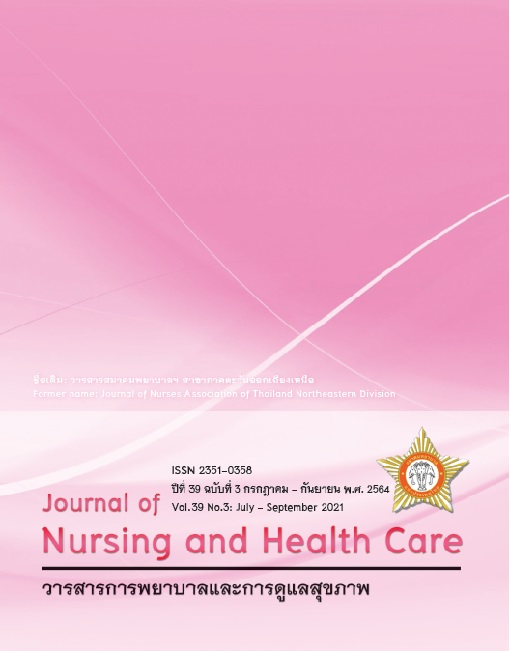การพัฒนารูปแบบการป้องกันการดื่มเครื่องดื่มที่มีแอลกอฮอล์ และสูบบุหรี่สำหรับผู้สูงอายุในชุมชน
คำสำคัญ:
การป้องกัน, การดื่มเครื่องดื่มแอลกอฮอล์, การสูบบุหรี่, ผู้สูงอายุ, การมีส่วนร่วมบทคัดย่อ
การวิจัยเชิงปฏิบัติการนี้มีวัตถุประสงค์เพื่อพัฒนารูปแบบการป้องกันการดื่มเครื่องดื่มที่มีแอลกอฮอล์และสูบบุหรี่สำหรับผู้สูงอายุในชุมชน แบ่งเป็น 2 วงรอบ วงรอบที่ 1 ศึกษาสถานการณ์ของผู้สูงอายุในชุมชน 627 คน วงรอบที่ 2 พัฒนารูปแบบการป้องกันการดื่มเครื่องดื่มที่มีแอลกอฮอล์และสูบบุหรี่สำหรับผู้สูงอายุ คัดเลือกผู้ร่วมวิจัยแบบเฉพาะเจาะจง จำนวน 57 คน เก็บข้อมูลระหว่างเดือนเมษายน พ.ศ.2563 ถึง มกราคม พ.ศ. 2564 วิเคราะห์ข้อมูลเชิงปริมาณโดยใช้สถิติเชิงพรรณนา และข้อมูลเชิงคุณภาพใช้การวิเคราะห์ข้อมูลเชิงแก่นสาระ
ผลการวิจัย วงรอบที่ 1 พบว่าในผู้สูงอายุ 627 คน ดื่มเครื่องดื่มที่มีแอลกอฮอล์หรือสูบบุหรี่ 117 คน เป็นเพศชาย 116 คน และขาดการมีส่วนร่วมในการแก้ไขปัญหา วงรอบที่ 2 พัฒนารูปแบบการป้องกันการดื่มเครื่องดื่มที่มีแอลกอฮอล์และสูบบุหรี่สำหรับผู้สูงอายุในชุมชน 3 ระยะ ได้แก่ 1) การป้องกันการดื่มเครื่องดื่มที่มีแอลกอฮอล์และสูบบุหรี่ในทุกกลุ่มวัย 2) การป้องกันการเกิดโรคหรือผลกระทบต่อสุขภาพสำหรับผู้สูงอายุ และ 3) การป้องกันความเสื่อมถอยหรือภาวะทุพลภาพในผู้สูงอายุ หลังใช้รูปแบบพบว่าในผู้สูงอายุที่ดื่มแอลกอฮอล์และสูบบุหรี่ 20 คน สามารถเลิกดื่มเครื่องดื่มที่มีแอลกอฮอล์ได้ 4 คน เลิกสูบบุหรี่ได้ 3 คน ผู้สูงอายุและผู้ดูแลมีความพึงพอใจในการร่วมกิจกรรมในระดับมากที่สุด ( = 4.75, S.D = 1.20)
Downloads
เอกสารอ้างอิง
1. National Statistical Office. Results of the Smoking Behavior Survey 2017 [Internet]. 2018[cited2020 Dec 9]. Available from: http://www.nso.go.th/sites/2014/DocLib14/News/2561/08-61/N31-08-61-1.pdf
2. World Health Organization. WHO report on the global tobacco epidemic 2019 [Internet]. 2019 [cited2020 Dec 9]. Available from: https://apps.who.int/iris/handle/10665/326043
3. World Health Organization. WHO global report on trends in prevalence of tobacco smoking 2000-2025, third edition [Internet]. 2019 [cited2020 Dec 9]. Available from: https://www.who.int/ publications /i/item/who-global-report-on-trends-in-prevalence-of-tobacco-use-2000-2025-third-edition
4. Vadeesathakit P, Patanavanich R. Reduce cigarettes, reduce the burden of “Cigarettes, the number 1 cause of sickness/ death of Thai people. [Internet]. 2019 [cited2019 Nov 17]. Available from: http://bodthai.net /download/bod_ press-ลดบุหรี่ลดภาระ
5. Division of Health Education. Learning to modify smoking behavior for working adults. Bangkok: O-Wit (Thailand) Co., Ltd; 2017.
6. Asanangkonchai S. Report on the situation of alcohol consumption by province, 2017. Bangkok: Sahamit Phatthana Printing (1992); 2017.
7. Office of Health Promotion, Department of Health. The dangers of beverages containing alcohol. Health effects, both to themselves and those around her. (Public Health Personnel) [Internet]. 2019 [cited2020 Jan 20]. Available from: https://multimedia.anamai. moph.go.th/associates/hp-ebook_13/
8. Nakhon Phanom Provincial Public Health Office. Screening and treatment of tobacco dependence [Internet]. 2019 [cited2019 Nov 17]. Available from: https://npm.hdc.moph.go.th/hdc/reports/report.
9. Chatakan W. Action Research. Surat Thani Rajabhat Journal 2015; 2 (1): 29-49.
10. Braun V, Clarke V. Using thematic analysis in psychology. Qualitative Research in Psychology 2006; 3 (2): 77–101.
11. Rattanachompoo J, Noosorn N. The New Smoker Protection: Thailand Society has to Modify. Boromarajonani College of Nursing, Uttaradit Journal 2020; 12 (1): 13-27.
12. Sangchan S, Kempanya P, Beauchumn N, Boonbupha A, Hongsawong A, Phonlok M. Development of smoking-free community model by community participation in Ban Nongyangchin moo 7, ThambonNongyangchin, Reanunakhon district, NakhonPanom province [Internet]. 2013 [cited2020 Jan 19]. Available from: http://www.trc.or.th/trcresearch/pdffiles/ART%2014/cat14%20(5).pdf
13. Muangchuen S, Charoensuk J, Wongphaet S. Effectiveness of an integrated care model for people with alcohol consumption problems. Chiang Muan Hospital Phayao Province. Region 4-5 medical journal 2017; 36 (2): 89-100.
14. Ampaipun U, Chanmolee S. Suwan P. The development of smoking cessation model for the elderly in sub-district health promoting hospital of Nakhon Pathom Province. Journal of Social Science and Buddhistic Anthropology 2020; 5 (3): 1-19.
15. Panya P. Sethabouppha H. Jomsri P. Experiences of relapse among elderly with alcohol dependence. Nursing Journal 2013; 40 (4): 45-55.
16. Khorphon S, Pankeaw J, Sarobol T, Sitthisongkram S, Chaisrisawat S, Chaisrisawat S. Norsak P. Use of Participatory Action Research (PAR) in Preventing and Solving Problems Caused by Alcohol Consumption in the Community of Nong Toa Kammai Village, Pa Phai Sub-district, San Sai District, Chiang Mai Province. Journal of Community Development and Life Quality 2014; 2 (3); 313-24.
17. Jaramorn K, Niamnuy N, Saonuam P. Case Study: Community Participation Development Model to Reduce Alcohol Consumption. Health Systems Research Institute 2017; 11 (2): 268-76.
18. Muenhor C. Daenseekaew S. Development community participation model to reduce of cigarette smoke contact in the risk group of chronic obstructive pulmonary disease. Journal of Nursing and Health Care 2016; 34 (4): 37-44.



